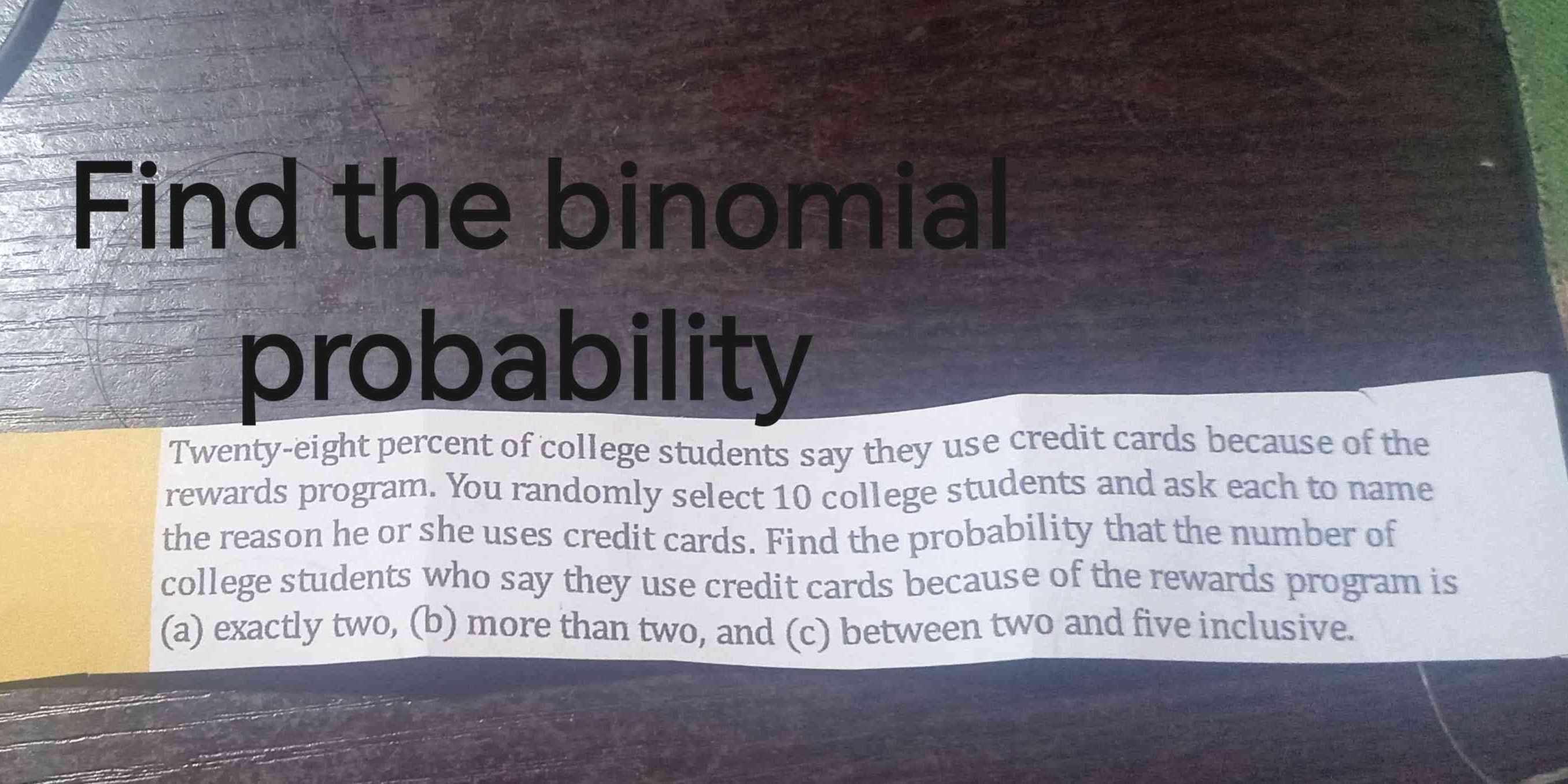Twenty-eight percent of college students say they use credit cards because of the rewards program. You randomly select 10 college students and ask each to name the reason he or she... Twenty-eight percent of college students say they use credit cards because of the rewards program. You randomly select 10 college students and ask each to name the reason he or she uses credit cards. Find the probability that the number of college students who say they use credit cards because of the rewards program is (a) exactly two, (b) more than two, and (c) between two and five inclusive.

Understand the Problem
The question is asking to find the binomial probabilities related to college students using credit cards for specific reasons, based on given percentages and sample size. We will determine the probabilities for various specified conditions.
Answer
(a) Approximately 0.197, (b) Approximately 0.585, (c) Approximately 0.791.
Answer for screen readers
(a) The probability that exactly two students use credit cards because of the rewards program is approximately 0.197.
(b) The probability that more than two students use credit cards because of the rewards program is approximately 0.585.
(c) The probability that between two and five students (inclusive) use credit cards because of the rewards program is approximately 0.791.
Steps to Solve
- Define the Parameters for the Binomial Distribution
We define the parameters of the binomial distribution:
- Number of trials (n): 10 (the number of college students surveyed)
- Probability of success (p): 0.28 (the probability a college student uses credit cards for rewards)
- Probability of failure (q): $q = 1 - p = 0.72$
- Calculate the Probability for Exactly Two Students (a)
Using the binomial probability formula:
$$ P(X = k) = \binom{n}{k} p^k q^{n-k} $$
For exactly two students ($k = 2$):
$$ P(X = 2) = \binom{10}{2} (0.28)^2 (0.72)^{10-2} $$
Calculate the components:
$$ \binom{10}{2} = \frac{10 \cdot 9}{2 \cdot 1} = 45 $$
And:
$$ P(X = 2) = 45 \cdot (0.28)^2 \cdot (0.72)^8 $$
- Calculate the Probability for More Than Two Students (b)
To find the probability of more than two students, we calculate:
$$ P(X > 2) = 1 - P(X \leq 2) $$
Compute $P(X \leq 2)$ as:
$$ P(X \leq 2) = P(X = 0) + P(X = 1) + P(X = 2) $$
Using the binomial probability formula for $k = 0$ and $k = 1$:
- For $k = 0$:
$$ P(X = 0) = \binom{10}{0} (0.28)^0 (0.72)^{10} $$
- For $k = 1$:
$$ P(X = 1) = \binom{10}{1} (0.28)^1 (0.72)^{9} $$
- Calculate the Probability for Between Two and Five Students Inclusive (c)
For this condition, we compute:
$$ P(2 \leq X \leq 5) = P(X = 2) + P(X = 3) + P(X = 4) + P(X = 5) $$
Calculate each term:
- For $k = 3$:
$$ P(X = 3) = \binom{10}{3} (0.28)^3 (0.72)^{10-3} $$
- For $k = 4$:
$$ P(X = 4) = \binom{10}{4} (0.28)^4 (0.72)^{10-4} $$
- For $k = 5$:
$$ P(X = 5) = \binom{10}{5} (0.28)^5 (0.72)^{10-5} $$
- Summarize the Calculated Probabilities
After calculating all necessary individual probabilities for each part (a, b, and c), we will sum them properly to get the final probabilities required.
(a) The probability that exactly two students use credit cards because of the rewards program is approximately 0.197.
(b) The probability that more than two students use credit cards because of the rewards program is approximately 0.585.
(c) The probability that between two and five students (inclusive) use credit cards because of the rewards program is approximately 0.791.
More Information
The binomial distribution is used here as we are dealing with a fixed number of independent trials (students), each with two possible outcomes (uses credit card for rewards or not). The percentages represent a common survey finding among college students.
Tips
- Forgetting to calculate $P(X \leq 2)$ as a cumulative distribution when finding $P(X > 2)$.
- Miscalculating individual terms in the binomial formula.
- Confusing between inclusive and exclusive probabilities (for example, counting 2-5 correctly).
AI-generated content may contain errors. Please verify critical information